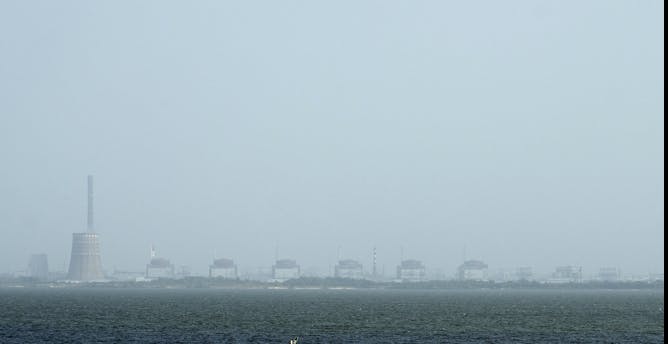|
The Zaporizhzhya nuclear power plant in eastern Ukraine was directly attacked in a drone strike earlier this month, which put the entire facility at risk. While the circumstances of the strike on April 7 remain murky, it is clear that ongoing hostilities present a risk to Ukraine’s nuclear power infrastructure.
Today in The Conversation Canada, Nino Antadze of the University of Prince Edward Island discusses the war in Ukraine and the ongoing risks of radioactive pollution that Russia’s invasion has brought to the region.
“As long as there is war in Ukraine, the threats to nuclear and radiation safety are real,” she argues.
“Regardless of whether there are direct attacks on sites with radioactive material or if disruptions inhibit their safe operation, the consequences of the radioactive contamination will be significant and long-lasting.”
Also today:
All the best.
|

A view of the Russian-controlled Zaporizhzhya nuclear power plant on the Dnipro River near Nikopol, Ukraine.
(AP Photo/Evgeniy Maloletka)
Nino Antadze, University of Prince Edward Island
The Russian invasion of Ukraine has placed Ukraine’s nuclear sites under considerable threat with a growing risk that further conflict may lead to radioactive contamination.
|

Canada should be making room for measures of personal and collective well-being other than GDP, including price stability, lower levels of inequality and happiness.
THE CANADIAN PRESS/Adrian Wyld
Michael M. Atkinson, University of Saskatchewan; Haizhen Mou, University of Saskatchewan
Drawing on insights from their recent book, two academics shed light on why Canada’s anemic growth should be a cause for concern.
|

Over time, normative gender roles have perpetuated a tendency for men to suffer in silence leaving them unable to disclose and address the challenges they face.
(Shutterstock)
Ellen Choi, Toronto Metropolitan University; Allen Sabey, Northwestern University
Constrictive social norms and views of masculinity still prevent many men from being vulnerable and seeking help, which is impacting their mental well-being.
|

Carrots grown in home gardens typically look like this — but grocery chains seem to think consumers won’t buy them. Here’s where marketing education can make a difference and help eliminate food waste.
(Shutterstock)
Narmin Tartila Banu, Carleton University; Aron Darmody, Carleton University; Leighann C. Neilson, Carleton University
New research suggests educators can play a crucial role in changing attitudes and actions about food waste and equip future marketing professionals with the tools to tackle sustainability challenges.
|

Pour l'instant, les prouesses créatives de l'Intelligence artificielle ne peuvent émerger qu'en collaboration avec la personne derrière l'écran.
(Shutterstock)
Pier-Luc de Chantal, Université du Québec à Montréal (UQAM)
L’IA est en mesure de générer des produits créatifs, qui remportent même des concours d’art. Mais cela signifie-t-il que ses produits sont le résultat d’un processus créatif ?
|
Business + Economy
|
-
George Kladakis, University of St Andrews
A recent corruption case in Vietnam has led to the owner of a bank being sentenced to death.
|
|
Health
|
-
Adrian Hill, University of Oxford
Malaria has been around longer than humankind. The endgame for this deadly parasitic disease is in sight.
|
|
Politics
|
-
Colleen Murrell, Dublin City University
Israel continues to restrict international journalists access to Gaza, and Palestinian reporters are being killed.
|
|